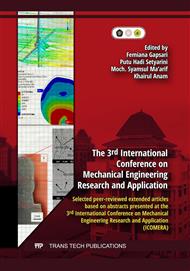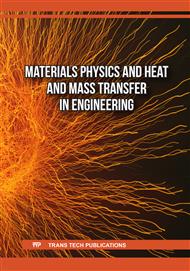[1]
F. Gapsari, P. H. Setyarini, K. Anam, S. Azizah, and R. Yuliati, "The effect of hot dip galvanizing temperature to corrosion rate of steel as the material for chopper machine," Solid State Phenom., vol. 291, p.148–154, 2019.
DOI: 10.4028/www.scientific.net/SSP.291.148
Google Scholar
[2]
W. Suprapto, Zuliantoni, P. H. Setyarini, F. Gapsari, Sudjito, and Y. S. Irawan, "Corrosion Resistance Analysis of Al-Cu, Al-Zn and Al-Cu-Zn Alloys," in Key Engineering Materials, vol. 935, 2022.
DOI: 10.4028/p-04p5jx
Google Scholar
[3]
F. Gapsari, R. Soenoko, A. Suprapto, and W. Suprapto, "Minimization of corrosion rate using response surface methodology," Engineering Review. 2018.
Google Scholar
[4]
R. Soenoko, P. H. Setyarini, S. Hidayatullah, M. S. Ma'Arif, and F. Gapsari, "Corrosion characterization of cu-based alloy in different environment," Metalurgija, vol. 59, no. 3, 2020.
Google Scholar
[5]
F. Gapsari, R. Soenoko, A. Suprapto, and W. Suprapto, "Green inhibitor for API 5L x65 steel in HCL 0.5 m," ARPN J. Eng. Appl. Sci., 2016.
Google Scholar
[6]
O. Olawale, A. O. Oyawale, A. A. Adediran, and A. S. Obafemi, "Corrosion Inhibition of Mild Steel in Seawater using Jatropha Stem," Analele Univ. "Eftimie Murgu" Reşiţa, no. October, p.228–238, 2016.
Google Scholar
[7]
P. Morales-Gil, G. Negrón-Silva, M. Romero-Romo, C. Ángeles-Chávez, and M. Palomar-Pardavé, "Corrosion inhibition of pipeline steel grade API 5L X52 immersed in a 1 M H2SO4 aqueous solution using heterocyclic organic molecules," Electrochim. Acta, 2004.
DOI: 10.1016/j.electacta.2004.05.029
Google Scholar
[8]
F. El-Hajjaji et al., "Experimental and quantum studies of newly synthesized pyridazinium derivatives on mild steel in hydrochloric acid medium," in Materials Today: Proceedings, 2019.
DOI: 10.1016/j.matpr.2019.04.045
Google Scholar
[9]
M. Abdallah, "Corrosion behaviour of 304 stainless steel in sulphuric acid solutions and its inhibition by some substituted pyrazolones," vol. 82, p.786–792, 2003.
DOI: 10.1016/S0254-0584(03)00367-5
Google Scholar
[10]
A. Y. El-Etre and M. Abdallah, "Natural honey as corrosion inhibitor for metals and alloys. II. C-steel in high saline water," Corros. Sci., vol. 42, no. 4, p.731–738, 2000.
DOI: 10.1016/S0010-938X(99)00106-7
Google Scholar
[11]
P. B. Raja and M. G. Sethuraman, "Natural products as corrosion inhibitor for metals in corrosive media — A review," vol. 62, p.113–116, 2008.
DOI: 10.1016/j.matlet.2007.04.079
Google Scholar
[12]
A. Miralrio and A. E. Vázquez, "Plant extracts as green corrosion inhibitors for different metal surfaces and corrosive media: A review," Processes, vol. 8, no. 8. 2020.
DOI: 10.3390/PR8080942
Google Scholar
[13]
F. Gapsari, S. Hidayatullah, P. Hadi Setyarini, K. A. Madurani, and H. Hermawan, "Effectiveness of a fish scales-derived chitosan coating for corrosion protection of carbon steel," Egypt. J. Pet., vol. 31, no. 1, 2022.
DOI: 10.1016/j.ejpe.2022.02.001
Google Scholar
[14]
F. Gapsari, H. Wijaya, Andoko, and A. Suprapto, "The performance of bee wax propolis inhibitor on the Ductile Cast Iron (DCI) in saline and acidic environment," Int. Rev. Model. Simulations, vol. 12, no. 3, 2019.
DOI: 10.15866/iremos.v12i3.17085
Google Scholar
[15]
W. Suprapto, R. Soenoko, A. Suprapto, and F. Gapsari, "The inhibition of 304SS in hydrochloric acid solution by cera alba extract," J. Eng. Sci. Technol., 2017.
Google Scholar
[16]
F. Gapsari, K. A. Madurani, F. M. Simanjuntak, A. Andoko, H. Wijaya, and F. Kurniawan, "Corrosion inhibition of honeycomb waste extracts for 304 stainless steel in sulfuric acid solution," Materials (Basel)., 2019.
DOI: 10.3390/ma12132120
Google Scholar



